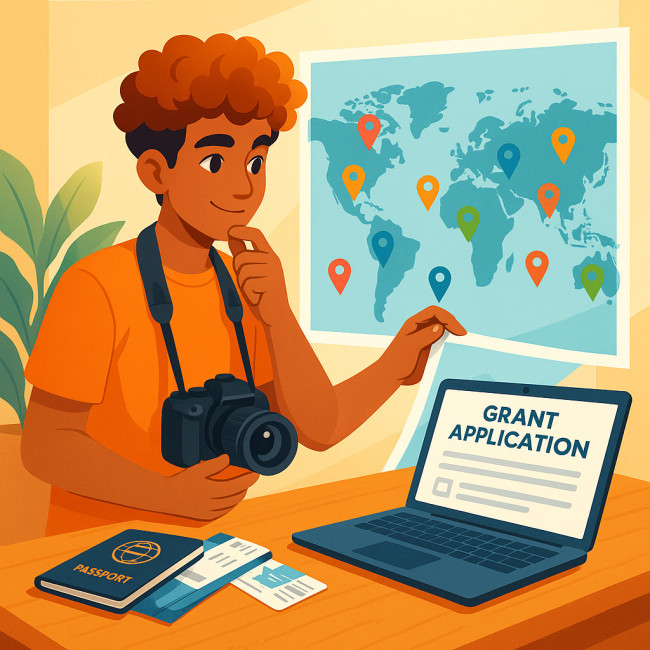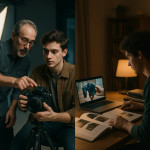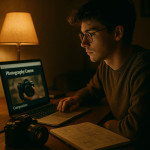Grants that finance photo study trips: where to search and how to apply
Dreaming of sharpening your visual voice in Tokyo's neon streets or Iceland's serene glaciers? Good news: dozens of public and private grants exist to fund photo study trips if you know where to look—and how to pitch. This guide maps the best search hubs, explains selection criteria, and gives you a step-by-step method to file winning applications.
Why funders love photo study trips
Study journeys generate fresh portfolios, cross-cultural stories and, ultimately, public value through exhibitions, books or online learning. Funders—from ministries of culture to corporate foundations—view these trips as leverage: one small cheque can nurture a lifetime of impactful imagery.
Typical grant benefits
- Travel and accommodation budget (often capped at €5 000–€8 000)
- Per-diem for meals and local transport
- Equipment rental or insurance allowance
- Mentoring or local institutional support
- Visibility: exhibitions, catalogues, media coverage
Where to search efficiently

Whether you're an emerging street shooter hunting for neon metropolises or a seasoned landscape expert chasing Arctic light, knowing where to dig for funding can feel like panning for gold. National arts portals, regional exchanges, corporate foundations and academic residencies each hide distinct eligibility quirks, application windows and thematic priorities. Mapping them out in advance saves hours of doom-scrolling and prevents you from missing that one perfect call closing at midnight. The golden rule: subscribe, diarise and revisit listings weekly. RSS feeds, Google Alerts and community Discord servers amplify your radar, while a simple spreadsheet comparing budget caps, outcome expectations and jury timelines turns the hunt into a clear-cut strategy instead of a frantic last-minute gamble.
1. National arts councils
Start with your own country's cultural agencies. They usually release calls once or twice a year. Set calendar alerts and subscribe to newsletters. If you work in the EU, the Creative Europe portal lists transnational mobility schemes.
2. Regional exchange programmes
Neighbouring countries sign bilateral agreements supporting residencies. Example: the France–Japan Villa Kujoyama fellowship covers a six-month stay in Kyoto. Similar accords exist between Canada and Scandinavian nations.
3. Corporate foundations and NGOs
Camera brands, airlines and environmental NGOs fund themed expeditions. Think of the Leica Oskar Barnack Award travel bursary or Air France's Travel with Purpose initiative focusing on sustainable tourism imagery.
4. University and museum residencies
Many universities list open calls on their research pages. Museums such as the Finnish Museum of Photography host short residencies that include curatorial feedback alongside funding.
5. Curated grant directories
Save time with specialised platforms. The training section of Artfolio's photographer resources aggregates international scholarships with upcoming deadlines and eligibility filters.
Key eligibility filters you must tick
| Filter | Typical requirement | Action point |
|---|---|---|
| Nationality / residence | Citizen or long-term resident of grant's country | Prepare proof of address or passport copy |
| Career stage | Emerging (≤ 10 years) or mid-career (10–20 years) | Update CV with years active & major milestones |
| Project theme | Climate, heritage, social change, etc. | Align destination and concept with funder's mission |
| Output format | Exhibition, workshop, open-source archive | Promise a concrete, measurable deliverable |
| Budget clarity | Transparent, realistic & balanced | Use itemised sheets (see “Build a bullet-proof budget”) |
Build a bullet-proof budget in three steps
- Research real costs. Check flight comparators, hostel rates and gear rental to avoid guesswork.
- Separate fixed and variable expenses. Funders like seeing contingencies (≈ 10 %) to manage risk.
- Match milestones to cash flow. Link each payment tranche to tangible results—e.g., “Week 4: 40 processed negatives delivered.” For extra guidance, adapt templates from arts budget blueprints.
Crafting a proposal that stands out
1. Start with a razor-sharp objective
Replace “I want to visit India” with “I will document disappearing hand-tinting studios in Chennai to create an open-source archive and touring exhibit.” Specificity screams credibility.
2. Show narrative potential
Funders visualise outcomes. Embed one compelling sample image and a two-sentence synopsis that teases the story arc.
3. Demonstrate feasibility
- Letters of intent from local fixers or NGOs
- Pandemic & visa contingency plan
- Insurance certificates
4. Highlight legacy and access
Explain how audiences will engage with your work—not just gallery-goers but schools or online learners. For inspiration on accessibility gains, study tactics used by creators in inclusive digital projects.
5. Polish language & layout
Use active verbs, bullet lists and headers. Keep sentences under 25 words. A well-structured PDF mirrors the clarity you'll deliver on the ground.
Timeline: from idea to boarding pass
- D-90: Identify 5–7 grants; download guidelines.
- D-75: Draft concept note; contact local partners.
- D-60: Collect letters of support, portfolio samples and updated CV.
- D-45: Build budget & milestone plan.
- D-30: Peer review—swap with another artist, similar to feedback circles described in peer critique strategies.
- D-15: Proofread, export PDF under 4 MB, submit.
- Post-submission: Prepare interview pitch deck in case the jury shortlists you.
Common mistakes that sink applications
- Vague goals (“improve my portfolio”)
- No community benefit described
- Over-inflated gear purchases instead of rentals
- Ignoring sustainability—consider carbon-offset plans
- Submitting one generic proposal to multiple funders without adaptation
Success story snapshot
“The grant covered €6 200. I spent eight weeks in Kyrgyzstan documenting nomadic horse games, ran workshops at a local school and published an open-access zine. Clear milestones and letters from the NGO partner impressed the jury.”—Sara L., 2023 grantee
Mini quiz: test your grant-writing readiness
FAQ
- Can beginners win travel grants?
- Yes, if you show a cohesive project and some consistent portfolio pieces. Many programmes reserve slots for emerging talents with five years or less of practice.
- Do I need exhibition experience?
- Not always. Replace exhibition credits with alternative public outputs—online workshops, open-source archives or community talks.
- How many grants should I apply for at once?
- Three to five tailored applications increase odds without spreading you too thin.
- What happens if my budget changes on the road?
- Contact the funder immediately. Minor reallocations (≤ 15 %) are often accepted with written approval.
- Can I combine grant money with crowdfunding?
- Most funders allow co-financing as long as you declare all sources and avoid double funding for identical line items.
Next steps
Block two hours this week to audit upcoming calls. Pick one programme that aligns with your vision and start drafting. With clear objectives, a realistic budget and community-minded outcomes, your boarding pass—and new body of work—are within reach.
Ready to translate ideas into a funded journey? Download the free budget template in our grant proposal blueprint guide and take the first decisive step today.











